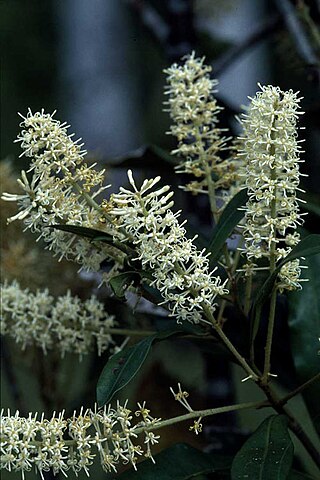
Grevillea, commonly known as spider flowers, is a genus of about 360 species of evergreen flowering plants in the family Proteaceae. Plants in the genus Grevillea are shrubs, rarely trees, with the leaves arranged alternately along the branches, the flowers zygomorphic, arranged in racemes at the ends of branchlets, and the fruit a follicle that splits down one side only, releasing one or two seeds.

Austrobaileya is the sole genus consisting of a single species that constitutes the entire flowering plant family Austrobaileyaceae. The species Austrobaileya scandens grows naturally only in the Wet Tropics rainforests of northeastern Queensland, Australia.

Lomatia is a genus of 12 species of evergreen flowering plants in the protea family Proteaceae. Within the family, they have been placed, alone, in their own subtribe, Lomatiinae according to Johnson & Briggs 1975 classification of the family and subsequently in Flora of Australia (1995).

Cardamine hirsuta, commonly called hairy bittercress, is an annual or biennial species of plant in the family Brassicaceae, and is edible as a salad green. It is common in moist areas around the world.

Austromuellera is a genus in the plant family Proteaceae, containing only two described species. It is placed in the tribe Banksieae, its closest relatives being the genera Musgravea and Banksia. It is endemic to restricted areas of the wet tropics rainforests of northeastern Queensland, Australia. The genus was erected in 1930 by the Australian botanist Cyril Tenison White, and named in honour of the Victorian State Botanist Ferdinand von Mueller.

Banksia hirta is a species of shrub that is endemic to Western Australia. It has hairy stems, deeply serrated leaves, pale yellow flowers in heads of about one hundred and shining follicles. It is restricted to the Stirling Range National Park.

Lepiderema is a genus of eight species of trees in the lychee family Sapindaceae native to New Guinea and eastern Australia, plus one more from Queensland that is yet to be formally described. The type species is Lepiderema papuana.

Arabis hirsuta, known as hairy rock-cress, is a flowering plant in the family Brassicaceae. In previous North American works, this species has been broadly defined to include plants native to Europe, Asia, and the northern half of North America, but is now more often restricted to a narrower subgroup restricted to Europe.

Normanbya is a monotypic genus of palms containing the single species Normanbya normanbyi, which is known by the common name black palm It is endemic to Queensland, Australia and is threatened by habitat destruction.

Euroschinus falcatus is a large tree in the mango and cashew family Anacardiaceae, found along almost the entire east coast of Australia from Cape York Peninsula to Jervis Bay. Common names include blush cudgerie and maiden's blush.

The Town of Brisbane was a local government area for Brisbane in Queensland, Australia from 1859 to 1903.

Tetratheca hirsuta, commonly known as black-eyed Susan, is a small shrub in the family Elaeocarpaceae. Endemic to the south-west of Western Australia, it is not related to other plants known as black-eyed Susan around the world.

Lepiderema pulchella, commonly known as fine-leaved tuckeroo, is a species of flowering plant in the family Sapindaceae and is endemic to coastal eastern Australia. It is a tree with pinnate, glossy light green leaves with four to fourteen leaflets, panicles of yellow-orange flowers and brown, spherical to three-lobed fruit.

Persoonia hirsuta, commonly known as the hairy geebung or hairy persoonia, is a plant in the family Proteaceae and is endemic to eastern New South Wales. It is a hairy, spreading to low-lying shrub with linear, lance-shaped or spatula-shaped leaves and yellow or orange flowers arranged singly or in groups of up to ten on a rachis up to 20 mm (0.79 in) long.

Nothorites is a monotypic genus in the macadamia family Proteaceae. The sole species, Nothorites megacarpus, is endemic to the wet tropics rain forests of northeastern Queensland, Australia.

Goodenia hirsuta is a species of flowering plant in the family Goodeniaceae and is endemic to northern Australia. It is a hairy, prostrate to low-lying perennial herb with narrow egg-shaped leaves at the base of the plant, racemes of hairy yellow flowers and oval to elliptic fruit.

Peperomia leptostachya, commonly known as slender peperomia or hairy peperomia, is a small succulent herb in the pepper family Piperaceae found in most parts of the Paleotropic floristic kingdom, from Africa through Asia to Australia and the western Pacific.

Mackinlaya macrosciadea, commonly known as mackinlaya or blue umbrella, is a plant in the carrot, fennel and parsley family Apiaceae, found in the Northern Territory and Queensland, Australia.

Meiogyne hirsuta is a plant in the family Annonaceae endemic to the Wet Tropics of Queensland in Australia. It is known from only a small number of collections from three widely separated locations in the Wet Tropics, namely Cedar Bay near Cooktown, the lower reaches of Mossman Gorge, and the foothills of the southern Atherton Tablelands in the vicinity of the North Johnstone River.

Polyosma hirsuta, commonly known as hairy polyosma, is a plant in the family Escalloniaceae which is endemic to northeastern Queensland, Australia. It is an evergreen small tree growing up to 10 m (33 ft) high. The leaves may be 6 to 14 cm long and 2 to 5 cm wide, often with toothed margins and each tooth exhibiting a short stiff spine. Most parts of the plant, including the twigs, leaves and fruit, are clothed in fine pale brown hairs.




















